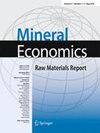研究在加里曼丹省东部萨马林达地区的巴利克帕潘形成的强压砂试验的规模效应
IF 3
Q1 ECONOMICS
引用次数: 0
摘要
在岩石上进行尺度效应试验,目的是了解岩石在不同尺寸下的强度。该试验采用单轴抗压强度试验,并对岩石的物理性质进行了测试。岩石抗压强度试验采用5个尺寸的岩样,其H/W比分别为:3 cm尺寸为4.5/ 3,6 / 3,7.5 /3,3.5 cm尺寸为5.25/3.5,7 /3.5,8.75/3.5,6/ 4,8 / 4,10 /4,4 cm尺寸为6.75/4.5,9/4.5,11.25/4,5 cm尺寸为4.5 cm, 7.5/ 5,10 /5和12.5/5。通过物理性质测试,确定测试岩样的孔隙度值,并将孔隙度值与岩样抗压强度测试结果进行比较。通过物性测试得到岩石孔隙度平均值分别为22.562%、22.122%、20.454%、21.227%和22.413%。在尺度效应试验中,根据Balikpapan组得到的R2值为0.0548,可知岩样越高,岩石强度值越小。本文章由计算机程序翻译,如有差异,请以英文原文为准。
Studi Efek Skala pada Uji Kuat Tekan Uniaksial Terhadap Batupasir Pada Formasi Balikpapan Daerah Samarinda Utara, Provinsi Kalimantan Timur
Scale effect testing on rocks is carried out with the aim of knowing the strength of a rock based on different dimensions. This test was carried out using a uniaxial compressive strength test and also testing the physical properties of rocks. In the rock compressive strength test used 5 dimensions of rock samples with a H/W ratio of which are 4.5/3, 6/3, 7.5/3 for dimensions of 3 cm, 5.25/3.5, 7 /3.5, 8.75/3.5 for dimensions 3.5 cm, 6/4, 8/4, 10/4, for dimensions 4 cm, 6.75/4.5, 9/4.5, 11.25/4,5 cm for the 4.5 cm dimension and for the 5 cm dimension, namely 7.5/5, 10/5 and 12.5/5. Physical properties testing is carried out to determine the porosity value in the test rock samples, which will then be compared between the porosity values and the results of the compressive strength test of rock samples. Physical properties testing carried out obtained the average value of rock porosity, namely 22.562%, 22.122%, 20.454%, 21.227%, and 22.413%. In the scale effect test, it is known that the higher the rock sample, the smaller the value of the rock strength can be seen based on the R2 value obtained in the Balikpapan Formation, which is 0.0548.
求助全文
通过发布文献求助,成功后即可免费获取论文全文。
去求助
来源期刊
CiteScore
5.00
自引率
12.00%
发文量
62
期刊介绍:
Mineral Economics – Raw Materials Report is an international multidisciplinary journal focused on economics and policy issues in the minerals metals and mining industries. The journal exists to improve the understanding of economic social environmental and political implications of natural resources. The main focus is on non-fuel minerals metals and the mining industry and its role in society.Mineral Economics is widening its scope and particularly invites papers on: Socio-economic aspects of mining e.g. social license to operate indigenous peoples theory of change Materials for the Green transition e.g. battery metals ICT elements policies to secure supply of these elements Minerals in the periphery e.g. the Arctic deep-seabed and space Mineral Economics serves as a platform for academics industry practitioners decision makers and other experts who want to share perspectives and knowledge about natural resources.A wide range of topics have traditionally been covered including among others: mineral market analysis exploration and development resource availability market development price formation international trade environmental policy sustainability issues competition issues.Mineral Economics is a joint project of Lule? University of Technology and R?varugruppen Ekonomisk F?rening the organization which founded the journal Raw Materials Report in 1981

 求助内容:
求助内容: 应助结果提醒方式:
应助结果提醒方式:


